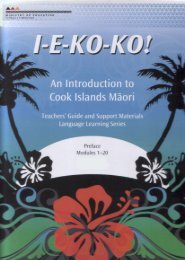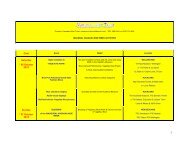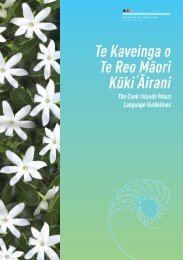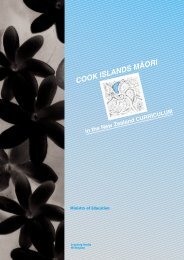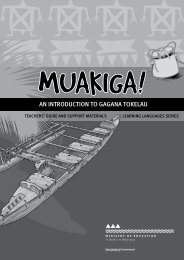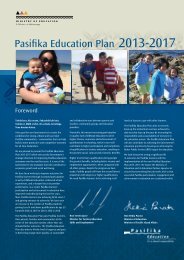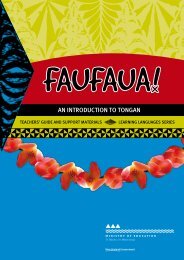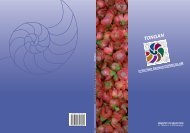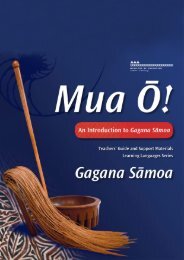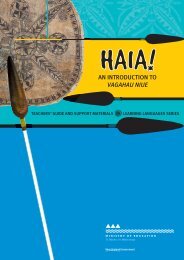Ta'iala mo le Gagana SÄmoa - Pasifika Education Community
Ta'iala mo le Gagana SÄmoa - Pasifika Education Community
Ta'iala mo le Gagana SÄmoa - Pasifika Education Community
Create successful ePaper yourself
Turn your PDF publications into a flip-book with our unique Google optimized e-Paper software.
A‘oa‘oina e Ala i <strong>le</strong> Poto MāsaniLearning ExperiencesA <strong>le</strong>arner-centred curriculum takes an interactive, experience-based, and communicative approach toteaching and <strong>le</strong>arning language. This approach aims to develop <strong>le</strong>arners’ communicative competence. 3Language <strong>le</strong>arners need opportunities to engage in a wide range of <strong>le</strong>arning activities appropriate tothe developmental stage they are at in their <strong>le</strong>arning. They need opportunities to participate incommunity situations in which gagana Sā<strong>mo</strong>a is spoken.Within <strong>le</strong>arning activities, the focus should be on contextualised, appropriate, and meaningfulcommunication in gagana Sā<strong>mo</strong>a. Whi<strong>le</strong> rote <strong>le</strong>arning based on surface features can help toreinforce particular patterns of language, <strong>le</strong>arners need to encounter and use language withinmeaningful contexts. They <strong>le</strong>arn to communicate best when they are engaged in meaningful andpurposeful interactions in the language they are <strong>le</strong>arning.The examp<strong>le</strong>s of <strong>le</strong>arning experiences that are given with the goals in the early childhood section(on pages 28–35) and under the heading Suggested Learning and Assessment Activities at each <strong>le</strong>velin the schools section (from page 53 to page 100) suggest a range of communicative, developmentallyappropriate activities that teachers may wish to use or adapt in their teaching and <strong>le</strong>arning programmes.The main focus of these activities is communication.As a general guide, teachers need to choose resources and activities that ref<strong>le</strong>ct the interests and needsof the <strong>le</strong>arners and the achievement objectives they need to meet. By se<strong>le</strong>cting a good range of the<strong>mo</strong>st effective teaching and <strong>le</strong>arning strategies, including who<strong>le</strong>-class activities, group work, pair work,ro<strong>le</strong> plays, and independent work, teachers can enab<strong>le</strong> <strong>le</strong>arners to:• draw on the language and the cultural skills they already have;• develop linguistic and intercultural competence (with growing <strong>le</strong>vels of precision and accuracy)as the foundation for fluency;• experience a wide range of texts and media in gagana Sā<strong>mo</strong>a;• experience gagana ma <strong>le</strong> aganu‘u fa‘asā<strong>mo</strong>a in a range of contexts;• use language (verbal and non-verbal) and cultural know<strong>le</strong>dge for different purposes;• experience positive expectations from their teachers and families;• respond to feedback on their progress;• have opportunities to manage their own <strong>le</strong>arning.21The Sa<strong>mo</strong>an cultural values of fa‘aaloalo, alofa, and tautua have implications for teaching and<strong>le</strong>arning programmes. It is important for teachers and <strong>le</strong>arners to recognise the relationshipbetween certain traditional ro<strong>le</strong>s and the underlying value system that has defined them.In planning inclusive programmes, teachers need to practise soālaupu<strong>le</strong> (the sharing of power).The concept of soālaupu<strong>le</strong> conveys the importance of col<strong>le</strong>ctive decision making and reciprocityof ro<strong>le</strong>s. It implies not only inclusiveness but also sensitivity to traditional ro<strong>le</strong>s and relationshipswithin aganu‘u fa‘asā<strong>mo</strong>a.When integrated into teaching and <strong>le</strong>arning programmes, Sa<strong>mo</strong>an cultural values (see pages17–18) will help teachers to provide authentic contexts for developing <strong>le</strong>arners’ understanding ofboth the language and the culture of Sā<strong>mo</strong>a.3 Communicative competence refers to a language user’s ability to use linguistic, contextual, and cultural know<strong>le</strong>dge effectively toachieve a communicative purpose.



